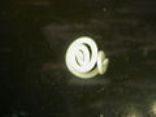Anisakis simplex
A Marine Parasite
Interesting Information
Though Anisakis simplex is intriguing simply because of its unique life cycle and pathological abilities, there are a few more interesting facts related to it.
 One interesting tidbit of information concerns the
prevention of pathology by Anisakis simplex. Even
though the organism can survive in the muscle tissue of the
dead marine species, it cannot survive extreme cold. Thus,
the United States Food and Drug Administration recommends
that all seafood to be served raw or undercooked be flash
frozen at -35 degrees Celsius for 15 hours or frozen at -20
degrees Celsius for seven days.
One interesting tidbit of information concerns the
prevention of pathology by Anisakis simplex. Even
though the organism can survive in the muscle tissue of the
dead marine species, it cannot survive extreme cold. Thus,
the United States Food and Drug Administration recommends
that all seafood to be served raw or undercooked be flash
frozen at -35 degrees Celsius for 15 hours or frozen at -20
degrees Celsius for seven days.
Another interesting fact regards the taxonomy of Anisakis simplex. As the organism has several sibling species, each becoming biochemically unique to a species of marine hosts, the presence of a specific form can be used to identify and track various fish stocks.
If you thought Anisakis simplex was interesting, check out these other amazing parasitic organisms:
~ Plasmodium falciparum ~ Heartworm
~ Borrelia burgdorfer ~ Deer Tick
~ Taenia solium ~ Trichuris vulpis
Though Anisakis simplex is intriguing simply because of its unique life cycle and pathological abilities, there are a few more interesting facts related to it.
 One interesting tidbit of information concerns the
prevention of pathology by Anisakis simplex. Even
though the organism can survive in the muscle tissue of the
dead marine species, it cannot survive extreme cold. Thus,
the United States Food and Drug Administration recommends
that all seafood to be served raw or undercooked be flash
frozen at -35 degrees Celsius for 15 hours or frozen at -20
degrees Celsius for seven days.
One interesting tidbit of information concerns the
prevention of pathology by Anisakis simplex. Even
though the organism can survive in the muscle tissue of the
dead marine species, it cannot survive extreme cold. Thus,
the United States Food and Drug Administration recommends
that all seafood to be served raw or undercooked be flash
frozen at -35 degrees Celsius for 15 hours or frozen at -20
degrees Celsius for seven days.Another interesting fact regards the taxonomy of Anisakis simplex. As the organism has several sibling species, each becoming biochemically unique to a species of marine hosts, the presence of a specific form can be used to identify and track various fish stocks.
If you thought Anisakis simplex was interesting, check out these other amazing parasitic organisms:
~ Plasmodium falciparum ~ Heartworm
~ Borrelia burgdorfer ~ Deer Tick
~ Taenia solium ~ Trichuris vulpis